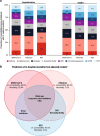A Narrative Review of Key Risk Factors for Severe Illness Following SARS-CoV-2, Influenza Virus, and Respiratory Syncytial Virus Infection
- PMID: 39739198
- PMCID: PMC11724830
- DOI: 10.1007/s40121-024-01081-3
A Narrative Review of Key Risk Factors for Severe Illness Following SARS-CoV-2, Influenza Virus, and Respiratory Syncytial Virus Infection
Abstract
Severe acute respiratory syndrome coronavirus 2 (SARS-CoV-2), influenza, and respiratory syncytial virus (RSV) are highly infectious respiratory viruses that affect people of all ages and are typically associated with mild symptoms and few complications in immunocompetent individuals. However, the risk of severe outcomes (e.g., hospitalization and death) following infection with these respiratory viruses is higher in certain populations, including older adults and individuals of certain race/ethnic and sociodemographic groups. Additionally, immunocompromising conditions and pre-existing comorbidities, including underlying cardiovascular (e.g., congestive heart failure) and respiratory diseases (e.g., chronic obstructive pulmonary disease), diabetes, chronic kidney disease, and obesity, are key factors that predispose individuals to SARS-CoV-2-, influenza-, and RSV-related severe outcomes. Increased risk for severe outcomes associated with advancing age and comorbidities is compounded by residence in long-term care facilities due to the enhanced spread of respiratory infections in congregate living environments. In this narrative review, risk factors associated with severe outcomes following infection with SARS-CoV-2, influenza, and RSV in adult populations are explored. Additionally, distinct clinical outcomes based on underlying comorbidities following infection are discussed in the context of high-risk populations. Factors unique to each virus that underpin distinct risk profiles are described and suggest the potential for tailored surveillance and healthcare approaches to target and ultimately mitigate SARS-CoV-2-, influenza-, and RSV-associated disease burden in vulnerable populations. Mutual risk factors for severe outcomes are also highlighted; these similarities indicate that cohesive risk reduction strategies may also be feasible, particularly since vaccines are available for each of these respiratory viruses. Ultimately, a more thorough understanding of the risk factors that predispose individuals to develop SARS-CoV-2-, influenza-, and RSV-related severe outcomes may improve risk reduction strategies, inform healthcare policy, and contribute to the expansion and refinement of existing surveillance approaches to ultimately mitigate disease burden in vulnerable populations.
Keywords: COVID-19; Comorbidities; Immunocompromised hosts; Influenza; Older adults; Respiratory syncytial virus; Risk factors; SARS-CoV-2.
© 2024. The Author(s).
Conflict of interest statement
Declarations. Conflict of Interest: Angela Branche and Mayure Ramesh are consultants for Moderna, Inc. Mayure Ramesh serves on advisory boards for Moderna, Inc., Pfizer, and MicroGen DX, and has been an unbranded speaker for Moderna and AstraZeneca. Angela Branche serves on advisory boards for Novavax and GSK, and received grant funding from Moderna, Inc., Pfizer, Cyanvac and Vaccitech. Beverly Francis is an employee of Moderna, Inc., and may hold stock/stock options in the company. Ethical Approval: This article is based on previously conducted studies and does not contain any new studies with human participants or animals performed by any of the authors.
Figures



Similar articles
-
Optimal Timing of Vaccination: A Narrative Review of Integrating Strategies for COVID-19, Influenza, and Respiratory Syncytial Virus.Infect Dis Ther. 2025 May;14(5):911-932. doi: 10.1007/s40121-025-01135-0. Epub 2025 Apr 10. Infect Dis Ther. 2025. PMID: 40205144 Free PMC article. Review.
-
Burden of Acute Respiratory Infections Caused by Influenza Virus, Respiratory Syncytial Virus, and SARS-CoV-2 with Consideration of Older Adults: A Narrative Review.Infect Dis Ther. 2025 Jan;14(Suppl 1):5-37. doi: 10.1007/s40121-024-01080-4. Epub 2024 Dec 30. Infect Dis Ther. 2025. PMID: 39739200 Free PMC article. Review.
-
Predictors of all-cause mortality among patients hospitalized with influenza, respiratory syncytial virus, or SARS-CoV-2.Influenza Other Respir Viruses. 2022 Nov;16(6):1072-1081. doi: 10.1111/irv.13004. Epub 2022 May 24. Influenza Other Respir Viruses. 2022. PMID: 35611399 Free PMC article.
-
The Impact of Vaccination on COVID-19, Influenza, and Respiratory Syncytial Virus-Related Outcomes: A Narrative Review.Infect Dis Ther. 2025 Jan;14(Suppl 1):63-97. doi: 10.1007/s40121-024-01079-x. Epub 2024 Dec 30. Infect Dis Ther. 2025. PMID: 39739199 Free PMC article. Review.
-
Focusing on severe infections with the respiratory syncytial virus (RSV) in adults: Risk factors, symptomatology and clinical course compared to influenza A / B and the original SARS-CoV-2 strain.J Clin Virol. 2023 Apr;161:105399. doi: 10.1016/j.jcv.2023.105399. Epub 2023 Feb 14. J Clin Virol. 2023. PMID: 36863135 Free PMC article.
Cited by
-
Differential susceptibility of immunodeficient mice to MPXV infection and the impact of various inoculation routes.Virol Sin. 2025 Jun;40(3):333-339. doi: 10.1016/j.virs.2025.04.001. Epub 2025 Apr 7. Virol Sin. 2025. PMID: 40204157 Free PMC article.
-
Optimal Timing of Vaccination: A Narrative Review of Integrating Strategies for COVID-19, Influenza, and Respiratory Syncytial Virus.Infect Dis Ther. 2025 May;14(5):911-932. doi: 10.1007/s40121-025-01135-0. Epub 2025 Apr 10. Infect Dis Ther. 2025. PMID: 40205144 Free PMC article. Review.
References
-
- Moriyama M, Hugentobler WJ, Iwasaki A. Seasonality of respiratory viral infections. Annu Rev Virol. 2020;7(1):83–101. 10.1146/annurev-virology-012420-022445. - PubMed
-
- Centers for Disease Control and Prevention. About COVID-19. https://www.cdc.gov/covid/about/. Accessed 7 Mar 2024.
-
- Centers for Disease Control and Prevention. Groups most impacted—emergency department visits. https://www.cdc.gov/respiratory-viruses/data/most-impacted.html. Accessed 7 Mar 2024.
-
- Centers for Disease Control and Prevention. About Influenza. https://www.cdc.gov/flu/about/index.html. Accessed 7 Mar 2024.
-
- Centers for Disease Control and Prevention. Protect yourself and others from Flu, COVID-19, and RSV. https://stacks.cdc.gov/view/cdc/96864/cdc_96864_DS1.pdf. Accessed 9 Apr 2024, Accessed 7 Mar 2024.
Publication types
LinkOut - more resources
Full Text Sources
Miscellaneous

